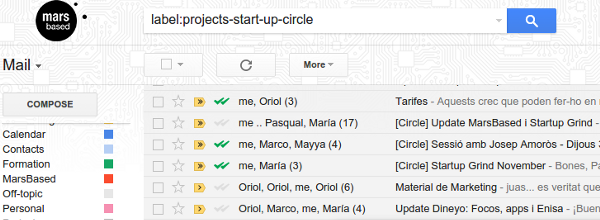Lead tracking for beginners
Allow me to take a break from my series of reviewing 2014 (see last post) to answer a question I get five times a week.
Ever since I frequent the entrepreneurial scene of Barcelona, MarsBased has come to be an example of rapid yet sustainable growth in the eyes of other entrepreneurs.
Our growth has been caused by many reasons, one of them is having one person dedicated 100% to sales.
I am mainly using two tools to keep track of our leads at MarsBased.
Mailtrack
Mailtrack is what every entrepreneur should use no matter what. Regardless of your job title, chances are that you need to know whether your emails are read or not.

Sent your pitch deck to an investor? Applied for public subventions? A provider takes too much to answer your emails? How about that overdue document from your lawyer? Etc.
Put simply, Mailtrack brings Whatsapp’s doublecheck-like notifications to your inbox. Furthermore, you can enable desktop notifications to get a pop-up every time somebody opens one of your emails.
Protip: If you receive a Mailtrack notification, it means it’s the right time to contact that person (phone, chat, twitter, what have you) because he or she will have dealt with the email in that very moment.
Useful when
- Sending emails with Gmail.
- You actually follow up these notifications actively.
- Need to take actions depending on recipient reading emails or not.
Not useful in these cases
- Can’t track mails sent from mobile devices.
- If mail is forwarded you can’t tell who’s who.
- Not accurate in mailing lists.
DocSend
Straight from Silicon Valley, DocSend is your analytics tool for documents you send (hence their moniker)

Docsend offers you a SaaS platform to upload your files and create custom links for each individual you want to track. By sending these links in your emails, DocSend tracks the behaviour of whoever opens the document (time spent per page, times accessed, percentage of document read, etc.).
Protip: You can create multiple links for a given document, to track different people.
Useful cases: Sending your pitch deck ppt to investors? See in what page do they spend more time in. Sending a contract to clients? See what page do they pay more attention to, because there’ll probably a conflict of interests there.
This will help you if they use that online version of the document viewer. If they choose to download the file, you’ll lose the tracking (but you can disable the download option). Also, DocSend recently announced they’re planning to end the free service for new users (UPDATE: DocSend is not discontinuing their free service. They’ll be just granting extra privilege to long-time users. That’s why you should sign up now nevertheless!), so you might want to sign up using this link.
Hope this will help you boost your sales. At the very least, it will make you understand your customers a little bit better.
Let me know your results in the comments section!
This post was originally published on Medium on 2015-01-10: Lead tracking for beginners.